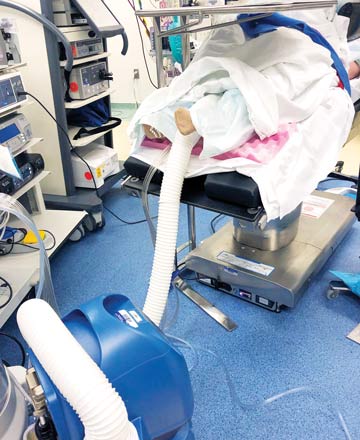Patients who were pre-warmed arrived in PACU with an average normothermic temperature of 36.2 ?C, whereas those who were not pre-warmed had an average hypothermic temperature of 35.7 ?C. We also discovered that pre-warming reduced the time patients spent in recovery; patients who were pre-warmed were discharged 2 minutes sooner than patients who were not. Two minutes might not seem like a significant difference, but it adds up over time. We perform about 20,000 procedures per year and estimate the couple minutes saved during each case would result in 600 fewer hours of PACU time.
We completed our trial at the end of 2018. There was a general consensus among staff and leadership that we should continue to pre-warm patients, but we're still working through how to move forward with the new strategy. Our decision will be based in part on a couple important lessons we learned during the trial.
- Consider all options. Our nurses struggled with transitioning the full-body, forced-air warming gowns into upper- and lower-body covers because the material was bulky and difficult to manage. Plus, each disposable gown costs $13, a significant per-case expense based on the amount of procedures we perform each year. Several convective and conductive active warming options are available. We'll keep an open mind as we assess the cost and practical application of each one, but we'll likely opt for a method that uses mattresses or coverlets instead of gowns.
- Standardized temperature taking. During our initial chart review, we discovered nobody took patients' temperatures the same way. Pre-op staff used oral thermometers, the OR team opted for esophageal probes or strip sticker thermometers, and PACU nurses used temporal scanners. That made it difficult to compare temperatures captured in each area.
We realized it's important to decide on a single temperature-taking method, and to use it consistently in pre-op, the OR and PACU.
During the trial, we instructed all staff to use a continuous temperature monitoring sensor. You place the half-dollar-sized sensor on the patient's forehead, near the temporal artery, and plug it into a wall-mounted control unit, which displays continuous temperature readings on an easy-to-read screen. As patients move from pre-op to the OR and to the PACU, staff unhook and reattach the sensor from control units mounted in each area. The system can even integrate with electronic anesthesia records to automatically record intraop temperatures.
Decide on a temperature-taking method, and use it consistently.
It's a simple, convenient and, perhaps most importantly, standardized way to capture accurate temperature readings during the entire surgical process.
- Facility-wide buy-in. Before the trial began, I created a PowerPoint presentation that touched on the basics of patient warming and distributed it to all pre-op, OR, PACU and anesthesia staff.
The education paid off. Most members of the perioperative team assumed patient warming was solely about making patients comfortable before surgery and were unaware of the complications it prevents. They were surprised to learn that pre-warming lessens the impact of redistribution hypothermia, the significant temperature drop that occurs when thermal energy shifts from the body's core to the periphery soon after anesthesia induction. Failing to pre-warm patients in pre-op forces you to play catch-up in the OR in order to maintain normothermia.
The trial ultimately showed us how to improve our patient warming practices and provided an opportunity to inform staff about a fundamental element of safe patient care. It was also a reason for nurses and anesthesia providers to team up to implement the pre-warming protocols. The entire process increased our understanding of why warming matters and improved our efforts to maintain normothermia in patients, who have told us they love being warmed in pre-op. If only they knew how much. OSM
.svg?sfvrsn=be606e78_3)

.svg?sfvrsn=56b2f850_5)